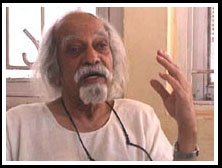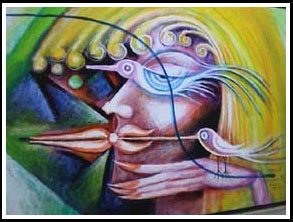|
 A Meeting with Laxman Pai A Meeting with Laxman Pai
Goans have dominated the world of art. In our previous issue we spoke about a legend, who lives no more-FN Souza. Here we are face to face with a living legend-Laxman Pai.
PADMASHRI Laxman Pai, one of the best living Goan painters, held an exhibition of his works after a long gap of 15 years at Panjim's Kala Academy last April. Pai's aesthetic works were sectioned in two interesting series, namely 'Sringar' and 'Spring Flowers', which provided a feast of glorious colours and flourishes the painter is famed for.
Goan painters--Hanuman Kambli, Querozito de Souza, Theodore Mesquita, Rajan Fulari and Om Prakash--decided to have a tete-a-tete with Laxman Pai at the Circuit House, Altinho, where the renowned artist was residing during the exhibition. We soon got to talking about the good old times and the prominent artists he had known or was associated with in his time. They included the famed Goan painter FN Souza, who had died just a month earlier in Bombay. Laxman Pai narrated several interesting facets of FN Souza's turbulent life as a painter and a person. He gives due credit to Souza, who might have had his idiosyncracies, for being among the first painters to move art into top gear.
MF Husain, FN Souza, Raza, Gade, Bakre (1947) were the guiding lights of the revolutionary movement of contemporary Indian art as represented by the Progressive Art Group. Reminiscing about MF Husain, Laxman Pai says that Hussain was accustomed to wearing a black cap way back in 1950. "During the Indo Pakistan war, some people pointing at him said, Daddiwala, Pakistani, pakadd lo usko. (There goes a bearded Pakistani, catch him.) So he shaved his beard," said Pai, smiling at the old memory.
Theodore Mesquita asked him pointedly, "Do you think the teachers there (Goa College or Art) are competent to teach?" Pai wasn't really taken by surprise by that poser. But he would not permit himself to be drawn into any controversy on the issue. The wise look in his rather impish yet still sharp eyes conveyed quite a bit. He said, "There is no ideal teacher. A teacher should have the ability to be a student. When I was here (Goa College of Art), I learnt so many things from the students."
Pai, a very warm as well as a very private person and an engaging conversationalist, always seem to wear a melancholy look on his countenance. Pai loves to joke, lapse into mother-tongue Konkani during the conversation.
 Mesquita persisted in his quest for an answer to his query, "You should know well because most of them (the teachers) were your students." Pai acknowledge the fact. He was the second Principal of the Goa College of Art, retiring after a tenure of ten years. He merely said, "They go according to the syllabus." Mesquita persisted in his quest for an answer to his query, "You should know well because most of them (the teachers) were your students." Pai acknowledge the fact. He was the second Principal of the Goa College of Art, retiring after a tenure of ten years. He merely said, "They go according to the syllabus."
"Laxman Pai, as the principal of the Goa College of Art inspired students by virtue of moral discipline and consistency required of a painter. He would discuss and continuously paint, which helped the first few batches of the College as far as work and discipline was concerned," recalls Hanuman Kambli, Pai's one-time pupil and now head of the printmaking department of the College. Kambli adds, "He would encourage every work and the encouragement coming from a reputed artist of his caliber was a great thing for us. He was a good art administrator, very receptive as far ideas in art were concerned."
Every year he used to hold an exhibition but before putting up any painting for the exhibition, he would show it to the students and discuss about it with them. He did a number of series while in Goa.
Pai said, "Analysis is what is very important, it keeps the mind working. When you are doing a work, if you like it, why do you like it? When you don't like it, why don't you like it? I had my own way of teaching which others may not like."
He wanted the Goa College of Art to be located in the vicinity of the Kala Academy as both would be complimentary to each other. Hence along with architect Sarto Almeida and others, he said that he worked out a plan and even the tenders were invited. But he said that Pratapsing Rane said that there was no parking space near the campus and hence the college was erected at the Altinho plateau.
The group of artists, who were his students once, were eager to know whether Pai had plans to settle in Goa and this would enrich the local art scene. "I have a house in Delhi. Now I am 76 and Delhi is getting very polluted. At first, I was hesitating (to think about settling in Goa) because my wife is not from Goa. She is from the North. So she was hesitant. But when the last time we came here…she seemed to like it. Delhi has also become very crowded. So now wife says it's alright if we can get a place here. So if I can get a place, I can come here."
Art, he observes, "is that art is mental nourishment and not a physical food for survival for the society, which is composed off different categories of people having different aspirations. A majority lives to earn and there are a few who earn to live. Physical and mental food is necessary for both these categories, but in varied proportions."
He opines that one reequires a peaceful and balanced mind to "appreciate any forms of art". Music, he says, is stimulation of the lower part of the body and satisfaction to the spiritual core of the upper mind. Pop music, for example, which is mostly based on rhythmic beats (beats nothing but beats) stimulates the lower part of the body, which is manifested with the movements of the feet and lower parts of the body.
As a Painter
From 1947 to 1950 Pai was largely inspired by Goan subjects and the concept of Indian miniatures. From 1950 to 1951, the Hindu Philosophy, influenced his paintings such as "Life is Dead", "Dead is life", "Blind Relationship" and others.
It was in such a state of mind, he said he had left for Paris in 1951 to pursue his studies and carry on painting. The Paris school of painting, did have a reaction on his work. From 1951 to 1952, he shifted his attention towards geometrical forms and facial structures. The two years from 1952 and 1953, saw Pai express himself through the oil medium, giving impetus to line work.
For him, the sacred character of the image is a heritage of our country's past. While moving towards abstraction, and geometrical forms which retained the quality of the sacred, is what is being observed in the portrait of a woman from Goa.
Though born of a Goan businessman father in Margao, Pai was possessed with a yearning to travel and shape his career as a painter. He honed his drawing skills at Margao's Mauzo Photo Studio, which was owned by his uncle. Along with well known Konkani poet Dr Manoharrai Sardesai, he also brought out several issues of a hand-written magazine, for which Pai did the illustrations and Sardessai penned beautiful poems.
Gandhi, the Ramayana, Kalidas' Ritu-Sambara, Indian classical music and dance forms, Kangra and Rajasthani paintings inspired him. He was also attracted attracted by the vivid colours and ethnic rhythms of evrything Goan. Even while in Paries, he drew from his memories of his ancestral place.
He is a very linear person. Strong lines and bright colours shine in his paintings. The gravity of linearity was much more emphatic in his heyday, before coming to Goa, though he did some exception work here. Subsequently colour became predominant and the decorative part out-distanced the substance. Yet, one has to appreciate his working discipline and very energetic life even at this late age. The conceptualization of image is still very strong.
While we took leave of the living legend from the pantheon of illustrious Goan painters, we wondered whether the likes of him lurk anymore in the corridors of the Goa College of Art. For Laxman Pai, art is not a mere hobby but an integral part of life.
Joel D'Souza |



